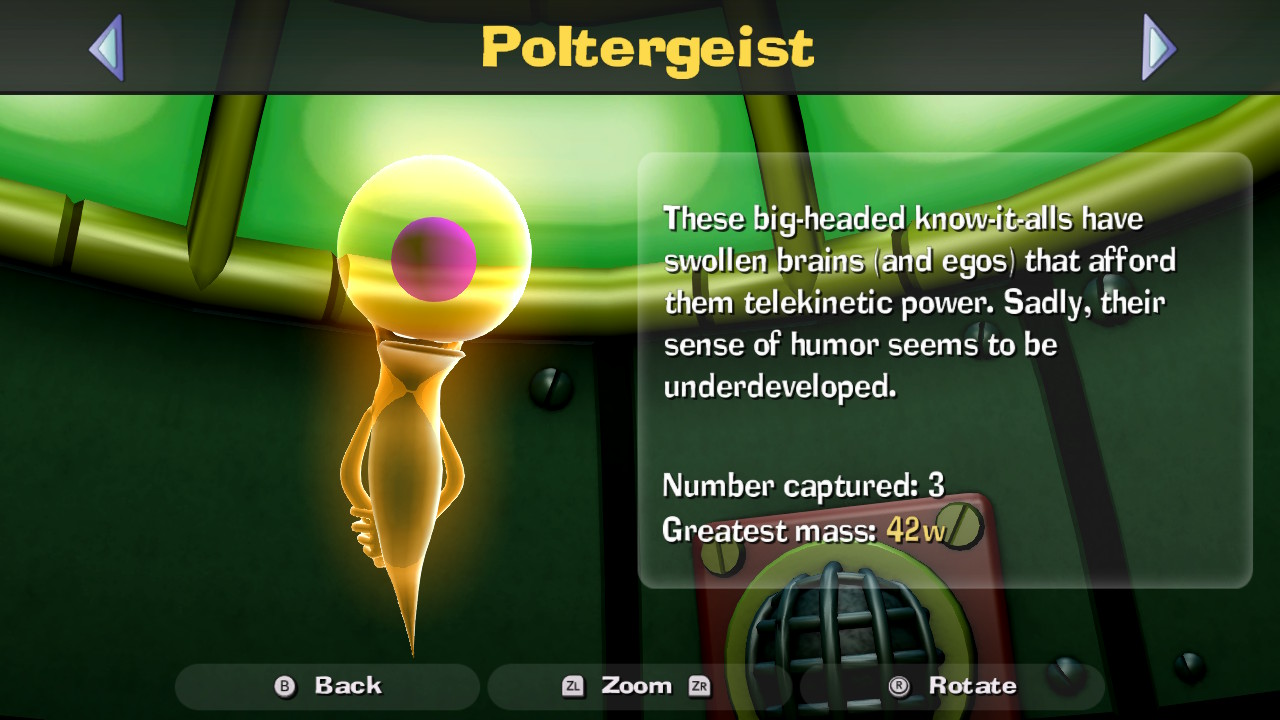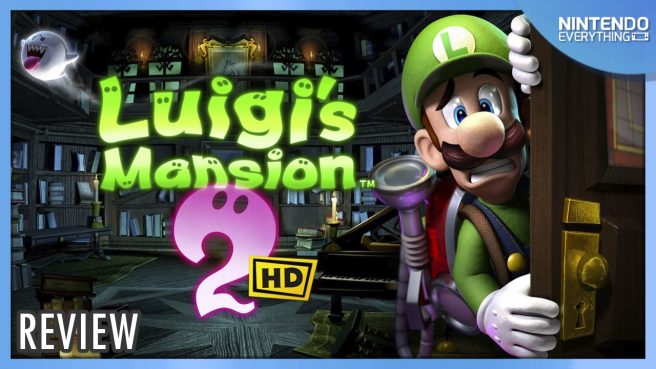System: Switch
Release date: June 27, 2024
Developer: Next Level Games / Tantalus
Publisher: Nintendo
When it was first released on the 3DS, Luigi’s Mansion: Dark Moon never really felt like a sequel to the Gamecube title to me, and it wasn’t until the release of Luigi’s Mansion 3 on Switch that its significance really hit home. But the game simply felt too ambitious for its own good at the time and felt like it would have been a better fit for the ailing Wii U, which was better equipped to deal with its increased scope, visual style, and was also in desperate need of more games, which the 3DS never had any shortage of. But with its release on the Switch, Luigi’s Mansion 2 HD feels as though it has finally been given some long overdue and much-needed room to breathe.
We’ve had a lot of remasters of first-party titles on Switch by now, and they’ve always tended to either remake the game from the ground up, or port it across with the bare minimum of gameplay changes. Luigi’s Mansion 2 HD falls into the latter category, so if you’ve played it before and were hoping for additional content to justify the notably higher price tag, this will come as a disappointment. There have been some changes to the title to make it a better fit for Switch, but this is fundamentally the same game that it was on the 3DS, for better and for worse. If you’ve already formed an opinion of Luigi’s Mansion: Dark Moon, this version of the game probably won’t be changing your mind.
Naturally, Luigi is the star of the show this time, and you’ll be controlling Mario’s more timid brother as he seeks to recover fragments of the Dark Moon, which has been shattered by King Boo. His tool of the trade is the Poltergust 5000, a multi-purpose device that allows you to activate switches to unlock doors and safes, reveal hidden doors and other objects, and, most importantly, suck up the hostile ghosts that are roaming the area and causing mischief. With this and the Dual Scream, which provides a map of the area and a direct line of communication to E. Gadd (complete with a very catchy ringtone), Luigi must make his way through each area as best he can, solving environmental puzzles in each room to progress. Despite its small toolkit the Poltergust can be used in a variety of clever ways, and the game is extremely good at telegraphing exactly what you need to do in order to progress without holding your hand through a very direct series of tutorials every time you run into an obstacle. But if you’ve played Luigi’s Mansion 3 on the Switch, or the original title on the Gamecube, you’ll be familiar with the core gameplay here.

However, this is where the similarities end. Even having dropped its Dark Moon subtitle to become a sequel in name, Luigi’s Mansion 2 HD is structured in a markedly different fashion to both its predecessor and its successor, making it a unique experience in the trilogy. Where seamless exploration is given a much greater emphasis in the other titles, Luigi’s Mansion 2 is structured almost like a traditional Mario title, taking you across five unique mansions which are further compartmentalized into a series of levels and a boss battle. You’ll have a specific objective to accomplish each time you enter, and will be immediately returned to Professor E. Gadd’s bunker once you’re done. The good professor will be constantly in your ear the entire time, guiding you in what often feels like an entirely unnecessary way when your objective is clearly marked on your map, and in most cases you’ll be in and out within fifteen minutes at most as a generous estimate, assuming you ignore everything and make straight for your objective. The story unfolds between levels, with classic Mario-style slapstick humor and charm in abundance as the reluctant Luigi finds himself thrust repeatedly into danger when he clearly just wants to go home and be left in peace. It’s rarely anything more than E. Gadd providing a little context for why he reduced Luigi to a quivering mess of pixels and is now having him carry out his dirty work yet again, but it’s a nice lighthearted break between stages.
Luigi’s Mansion 2 HD is a somewhat linear experience overall then, and although that doesn’t detract from the atmosphere of each area, it does give it a distinctly different flavor. The variety in locations is one of the game’s greatest strengths, with each mansion feeling like its own distinct biome (to the point that some of them definitely stretch the definition of what a “mansion” should be) and although you’ll be facing the same limited pool of ghostly enemies throughout the game it makes the boss battles feel particularly memorable. Each one is themed to the mansion they inhabit and has a satisfying puzzle-like structure to the encounter, as you’ll need to take advantage of the environment to successfully defeat them and recover the shards of the Dark Moon they possess. Most of the bosses are a slightly different take on environmental puzzles you’ll have been solving in the levels up to that point, making them feel intuitive and an enjoyable climax to your time in that area, and never too challenging that they become blocks to progression.

Exploration during each level is very limited given the size of the areas and the time you’ll spend in them, but not entirely unrewarded if you do choose to venture off the beaten path and take your time to interact with everything. There is a lot of money stashed in every nook and cranny, which will upgrade your Poltergust 5000 at set milestones, and finding each of the hidden Boos will also unlock a bonus level. What seems like a straightforward run through to an objective can turn into a lengthy treasure hunt if you take the time to comb each room for its secrets, and there are a number of small yet satisfying puzzles you may not necessarily be able to solve on your first visit, giving each level a degree of replayability.
You’ll also be given a rank for your performance based on the amount of treasure you’ve collected, damage taken, and number of ghosts captured. As you might expect, getting that perfect rating requires that you know the level well and hone your ghost-capturing skills to their fullest potential, and this is the area of the game that provides the most challenge to players looking for a little more out of the game than a straightforward story experience. It makes the title perfect for shorter play sessions and replays, which is unsurprising given its origins as a handheld release. However, it also slows the overall pacing of the game noticeably, and can be quite aggravating to deal with at times. More than once, just as I was beginning to get a sense for the area and feel as though I had made some progress, I would be forcibly dragged out of it. Although your objective changes with each level, the layout of the place doesn’t, forcing a lot of repeated backtracking to get to where you need to, and if you’ve already combed a room for its secrets, there is nothing new to surprise you. Fortunately none of the levels are long enough to overstay their welcome, and most of the mansions have five stages excluding the boss battle and bonus stage, but the lack of variety and repetition begins to take its toll over extended play sessions.

Motion controls have been implemented, and they are a significant improvement from the controls that featured in the 3DS original. As someone who dislikes motion controls and will generally avoid them entirely if given the chance (and thankfully, the game does give you that opportunity) I found that it felt surprisingly natural to use them for aiming, freeing up my right hand to use the Poltergust 5000’s various functions, which was otherwise a little awkward to do when I had to keep my thumb permanently glued to the right control stick to aim. The game can be quite chaotic during encounters with multiple ghosts, particularly when the camera angles often don’t give a clear view of where you’re aiming. You’ll need to adjust your aim a lot whilst also moving Luigi to avoid getting damaged, and it is slightly easier when you don’t need to keep shifting your hand between the right stick and buttons. Motion controls are also used for balancing when crossing narrow gaps at times, which I found to be far less intuitive, but the experience here is a notable improvement and the ability to turn them off and on at any point makes it much easier to play according to your personal preference.
Alongside the Dark Moon Quest, you also have access to the ScareScraper at E. Gadd’s bunker, the game’s multiplayer mode. Nintendo games are notoriously hit-and-miss when it comes to providing satisfying multiplayer content, but Luigi’s Mansion 2 offers an extremely robust package of options, with support for both local and online multiplayer, with the latter allowing you to play with both strangers and friends. There are three modes to choose from: in Hunter Mode the aim is to clear floors of ghosts as quickly as possible, Rush Mode is a timed race to find the exit to a floor, and Polterpup Mode has you seeking out the titular dogs with the Dark-Light Device. The overall focus is more on collaboration than competition, although scores are kept track of individually, and there is a surprising amount of variety available here, making it a good title to consider if you have friends who are interested in the game.
The visual improvements made to Luigi’s Mansion 2 are more than deserving of the HD moniker. Textures, lighting effects, and character models have all been significantly enhanced, and it has a much broader color palette that more than makes up for the lack of detail in some of the environments. It’s more than an upscaled 3DS title, and although it doesn’t quite measure up to Luigi’s Mansion 3, it effortlessly preserves the cartoonish charm that the series has, and has all the quality you would expect of a first-party title. Although loading times can run a little long at times and become noticeable the longer that you play and are forced back and forth between stages, it manages to hold a consistent framerate throughout and is a much smoother experience on the Switch.
The Verdict

Luigi’s Mansion 2 HD made the jump to the Switch much more smoothly than I expected, especially considering how little about it has been changed beyond the upgraded visuals and revamped controls. It turns out that this is more than enough to make it a much more enjoyable experience as, no longer held back by hardware limitations, the game is free to show all that it can be. Although it doesn’t quite measure up to its sequel, its linear mission-based structure marks it as a unique experience in the trilogy that is worth experiencing if you haven’t already.
Luigi’s Mansion 2 HD copy provided by the publisher for the purposes of this review.
